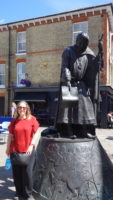 Today was one of the longer drives we have had on this trip – three hours (or so) from the Cotswolds to Canterbury, near the east coast.
Today was one of the longer drives we have had on this trip – three hours (or so) from the Cotswolds to Canterbury, near the east coast.
So (more or less) wrote Geoffrey Chaucer in his prologue to the great Canterbury Tales, written in the late 1300s. Mer has taught selections from the Tales, so it seemed I should get her here. There was also T. S. Eliot’s Murder in the Cathedral, an event which happened in this cathedral.
Our B and B is a fifteen-minute walk to the old gate of the walled part of the city (the gate is still intact, but the walls are mostly gone). We grabbed one last Cornish pasty from a bakery, and walked down the tourist-consumer gauntlet that is High Street here. Many of the buildings are very cool, and there were certainly tons of people trying to spend money today.
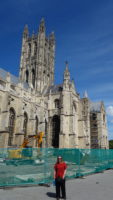 We got into the cathedral, which was open until 5:00, around 2:30. We had missed the live tours for the day, but we had a guide in Mer’s tour book, which we followed. The cathedral was built (roughly) between 1100 and 1400, but the site goes back to about 600. The bishop’s chair (which is what makes a cathedral more than a church) is from around 1300. We found some graffiti carved on the wall from the late 1600s. It’s been around for some time.
We got into the cathedral, which was open until 5:00, around 2:30. We had missed the live tours for the day, but we had a guide in Mer’s tour book, which we followed. The cathedral was built (roughly) between 1100 and 1400, but the site goes back to about 600. The bishop’s chair (which is what makes a cathedral more than a church) is from around 1300. We found some graffiti carved on the wall from the late 1600s. It’s been around for some time.
The cathedral is the headquarters (for lack of better term) of the Anglican church, so it is important in that respect. But it was put on the “pilgrimages” map by being the place where St. Thomas Becket’s body was entombed. Thomas Becket was the Archbishop of Canterbury, and he was murdered (somewhat by misunderstanding) in the church. Two years later, he was recognized as a saint, and the pilgrims started coming by the thousands.
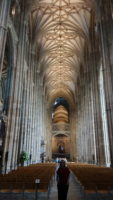 Becket was the childhood pal of the prince who would become Henry II. Henry and Thomas liked to party, and so when Becket was made bishop, Henry thought he was going to have the run of the country with little or no church interference. But, to Henry’s shock and dismay, Becket turned out to be a faithful bishop and kept opposing things Henry wanted to do. At some point, Henry is reported to have wished something could be done about Becket, which four knights interpreted as a desire to have Becket murdered. Which they did. In a church. Nice men. The king was horrified, and walked down the streets of Canterbury barefoot to the cathedral as a sign of repentance. (So ends my recollection of the story, which may be flawed.)
Becket was the childhood pal of the prince who would become Henry II. Henry and Thomas liked to party, and so when Becket was made bishop, Henry thought he was going to have the run of the country with little or no church interference. But, to Henry’s shock and dismay, Becket turned out to be a faithful bishop and kept opposing things Henry wanted to do. At some point, Henry is reported to have wished something could be done about Becket, which four knights interpreted as a desire to have Becket murdered. Which they did. In a church. Nice men. The king was horrified, and walked down the streets of Canterbury barefoot to the cathedral as a sign of repentance. (So ends my recollection of the story, which may be flawed.)
The cathedral is also the burial place of Henry IV and his queen – I have no idea why they aren’t in Westminster, but they are here. Since Shakespeare has Henry IV as a character in a couple of his plays, Mer was interested in the tomb. They also have the grave of the Black Prince Edward. I have no idea why he is the Black Prince, but he was feared in battle, so that may have much to do with it. Amazingly, the church still has some parts of his armor, including a fabric shirt that went under the armor.
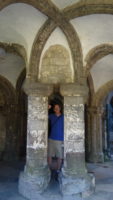 We were both moved by the Martyrs’ Chapel at the end of the church. It had a book listing multiple martyrs over the last 150 years. One group of whom we had not heard was a group of seven men in Melanesia (the Pacific islands toward Australia). They were in an area of hostilities, and they ignored the fronts to bring food and help to people trapped by rebels. When their leader was killed, the other six went to ask for his body. Three more were shot immediately and the other three were killed the next day after being tortured. Thousands of people came to the memorial service, and the leader of the rebels gave himself up to the authorities. It was a moving story among about twenty such.
We were both moved by the Martyrs’ Chapel at the end of the church. It had a book listing multiple martyrs over the last 150 years. One group of whom we had not heard was a group of seven men in Melanesia (the Pacific islands toward Australia). They were in an area of hostilities, and they ignored the fronts to bring food and help to people trapped by rebels. When their leader was killed, the other six went to ask for his body. Three more were shot immediately and the other three were killed the next day after being tortured. Thousands of people came to the memorial service, and the leader of the rebels gave himself up to the authorities. It was a moving story among about twenty such.
There was a small chapel that had stained glass from after World War II, to replace broken windows. It was done by a Hungarian artist, and the windows were bright and modern and moving. One window showed Jesus welcoming a prisoner set free, and the other window showed an old Jesus (aged by the world ignoring him) welcoming people from all races. They were thought-provoking, and I really liked the prisoner one especially.
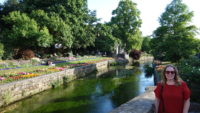 The crypt was open, and as we explored it, we heard an organ playing the contempory (2003) song “Here I Am to Worship.” It was a Christian pop song played on an organ in the crypt of a major cathedral, and it was for a French Huguenot service. There has been a French-language service in the church crypt for three hundred years, ever since French Huguenot Protestants fled France for religious reasons. They ended up here. And the confluence of so many things made us smile. Back up in the main part of the church, we heard the organist practicing “Pomp and Circumstance” – which Mer recognized even before the famous part; however, when the organist did get to that famous part, the first chord was so powerful that it drew Mer out of her seat.
The crypt was open, and as we explored it, we heard an organ playing the contempory (2003) song “Here I Am to Worship.” It was a Christian pop song played on an organ in the crypt of a major cathedral, and it was for a French Huguenot service. There has been a French-language service in the church crypt for three hundred years, ever since French Huguenot Protestants fled France for religious reasons. They ended up here. And the confluence of so many things made us smile. Back up in the main part of the church, we heard the organist practicing “Pomp and Circumstance” – which Mer recognized even before the famous part; however, when the organist did get to that famous part, the first chord was so powerful that it drew Mer out of her seat.
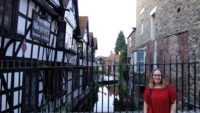 We explored a few streets around the cathedral, but went back for the 5:30 evensong service. It was a special service, held in the nave (the big part of the church). They were celebrating the one hundred years of service of a group called the Royal British Legion, whose mission is to serve veterans and the families of those who have served in the British armed forces. It was a moving service, with flags of the different military branches being marched in and being lowered during two minutes of silence toward the end of the service. Our Aunt Mary would have loved it – they opened with a hymn she loves, “Eternal Father, Strong to Save,” which asks God to protect those on the sea, something about which England has typically cared. The service lasted for a full hour, and we felt it a good worship experience, although we did pass on the singing of “God Save the Queen.” It’s hard for an American to sing about the joys of monarchy. We respectfully stood for the anthem.
We explored a few streets around the cathedral, but went back for the 5:30 evensong service. It was a special service, held in the nave (the big part of the church). They were celebrating the one hundred years of service of a group called the Royal British Legion, whose mission is to serve veterans and the families of those who have served in the British armed forces. It was a moving service, with flags of the different military branches being marched in and being lowered during two minutes of silence toward the end of the service. Our Aunt Mary would have loved it – they opened with a hymn she loves, “Eternal Father, Strong to Save,” which asks God to protect those on the sea, something about which England has typically cared. The service lasted for a full hour, and we felt it a good worship experience, although we did pass on the singing of “God Save the Queen.” It’s hard for an American to sing about the joys of monarchy. We respectfully stood for the anthem.
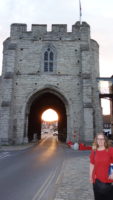 That was our day, more or less. We checked in to our B and B, and then had savory pies in a restaurant in a Tudor building next to a stream. But we were in literary company – the Frankeleyn (freeman) from the Tales:
That was our day, more or less. We checked in to our B and B, and then had savory pies in a restaurant in a Tudor building next to a stream. But we were in literary company – the Frankeleyn (freeman) from the Tales:
I do love the Navy hymn “Eternal Father, Strong to Save,” and your mention of it brought me to tears (after just having watched a Hallmark movie which made me cry).